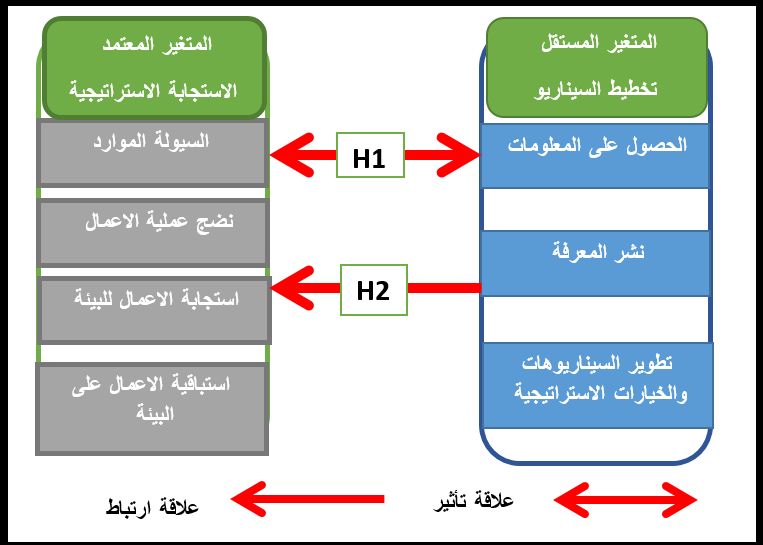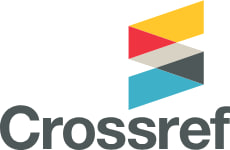impact of scenario planning on the strategic response
Keywords:
scenario planning, strategic responseAbstract
The current study aimed to identify the impact of scenario planning on the strategic response in the Shell Oil Company operating in southern Iraq. The study started with a main problem that included several questions, the most important of which was (Does the study sample have a clear vision or a sufficient awareness of the planning of the scenario and what is its impact on achieving the strategic response? The research community included the leaders of the Shell Oil Company operating in southern Iraq, and the study sample reached (186) person manager The questionnaire was used as a main tool for collecting data and information needed to complete the study, and for the purpose of analyzing and processing the data statistically, the study relied on a set of statistical methods available in the (SPSS V.23 program, Amos V.23). The study reached a set of conclusions, the most important of which was the presence of an impact of scenario planning on the strategic response, which is reflected in an improvement in the level of the company in question
References
تيغزة ، محمد بوزيان . (2012). التحليل العاملي الاستكشافي والتوكيدي : مفاهيمهما ومنهجيتهما بتوظيف حزمة SPSS وليزرل LISREL . الطبعة الاولى ، دارة المسيرة للنشر والتوزيع ، عمان ، الاردن .
Abuzaid, A. N. (2018). Scenario planning as approach to improve the strategic performance of multinational corporations (MNCs). Verslas: teorija ir praktika, 19(1), 195-207.
Amer, M., Daim, T. U., & Jetter, A. (2013). A review of scenario planning. Futures, 46, 23-40.
Ansoff, I. (2011). Critique of Henry Mintzberg’s “The Design School: Reconsidering the Basic Premises of Strategic Management”. Strategic Management Journal, 12(2) 449-461
Aosa, E. O. (2011). Strategic management within Kenya firms , DBA Africa management review , Vol 1 No 1
Barney, J. B., & Hesterly, W. S. (2008). Strategic management and competitive advantage: Concepts , Englewood Cliffs, NJ, USA: Prentice Hall.
Bartholomew , keith, (2005), Integrating Land Use Issues into Transportation Planning : Scenario Planning , Summary Report , College of Architecture - Planning University of Utah.
Bouhalleb , Arafet & Smida , Ali ( 2018 ) , Scenario planning: An investigation of the construct and its Measurement , Journal of Forecasting. 37(4) ,1–17. , Université Paris
Bowman, G. (2011). An empirical analysis of a scenario-informed strategic planning process: a public sector case (Doctoral dissertation, University of St Andrews).
Burt, G., Wright, G., Bradfield, R., Cairns, G., & Van Der Heijden, K. (2006). The role of scenario planning in exploring the environment in view of the limitations of PEST and its derivatives. International Studies of Management & Organization, 36(3), 50-76.
Cudanov, M., Jasko, O., & Savoiu, G. (2010). Interrelationships of organization size and information and communication technology adoption. Journal of Applied Quantitative Methods, 5(1).
Cui, B., Wang, S., & Xue, X. (2014). Effects and performance of a demand response strategy for active and passive building cold storage. Energy Procedia, 61, 564-567.
DaSilva-Glasgow, D., & Bynoe, M. (2012). Strategic Response to Evolving Food Safety Standards: A Case Study of Guyana’s Fish Export Sector. Estey Journal of International Law and Trade Policy, 13(1753-2016-141227), 201-215.
Derbyshire, J., & Wright, G. (2014). Preparing for the future: Development of an ‘antifragile’methodology that complements scenario planning by omitting causation. Technological Forecasting and Social Change, 82, 215-225.
Drew , S. A. (2006) , building technology foresight : using scenarios to embrace innovation " European journal of innovation management , Vol , 9 , N 3 , 241-257
Fink , Alexander & Marr , Bernard and Kuhle , Andreas Siebe and Jens-Peter ( 2005 ) , The future scorecard: combining external and internal scenarios to create strategic foresight , Management Decision Vol. 43 No. 3,
Gachambi , Mwangi, P. (2007). Strategic responses to changes in the external environment: a case of East African Breweries Limited ( MBA, University of Nairobi)
Grant, R. M. (2003). Strategic planning in a turbulent environment: Evidence from the oil majors. Strategic management journal, 24(6), 491-517
Griffith, D. A., Kiessling, T., & Dabic, M. (2012). Aligning strategic orientation with local market conditions: Implications for subsidiary knowledge management. journal International Marketing Review, Vol. 29 No. 4,
Ietto-Gillies, G. (2014). The organizational and geographical boundaries of the firm: strategic and policy issues for labour and governments.
Kaburi, M. P. (2013). Strategic responses to the changes in the business environment by Unaitas SACCO society ltd, Kenya (MBA, University of Nairobi
Lindgren, M and Bandhold, H. (2003). Scenario Planning: The Links between future and strategy. Palgrave Macmillan. New York
M. P. (2013). Strategic responses to the changes in the business environment by Unaitas SACCO society ltd, Kenya (MBA, University of Nairobi
Mavengere, N. B. (2013). Information technology role in supply chain’s strategic agility. International Journal of Agile Systems and Management, 6(1), 7-24
Mokua, J. M., & Muturi, W. (2015). Influence of strategic responses on the changes in the internal performance among pharmaceutical firms in Kisii County, Kenya. International Journal of Economics, Commerce and Management, 3(6), 11-25.
Motanya , N. (2013) "Strategic Responses By Weighing Scale Dealers In Kenya To Changes In External Environment", Master Thesis Of Business Administration , School Of Business, University Of Nairobi
Munyasya, S. (2014). Influence of strategic responses towards price regulation by the energy regulatory commission on performance of oil marketers in Kenya , research project submitted in partial fulfillment of the requirements for the award of the degree of master of business administration, school of business, university of Nairobi
Njari, A. K. K. O., & Muathe, S. M. (2018). Influence of Geographical Expansion Strategy on the Growth of East African Breweries Limited in Nairobi County, Kenya. International Journal of Management and Commerce Innovations, 5(2), 763-771.
Njuguna, A. G., & Arunga, A. (2013). Risk management practices: A survey of micro-insurance service providers in Kenya , International Journal of Financial Research Vol. 4, No. 1
Nthigah, P. M. (2016). Role of competition in determining choice of strategic response of multinational corporations in Kenya (Doctoral dissertation, Business Administration, JKUAT).
Nyokabi , M. M. (2018) " Strategic Responses To The Declining Underwriting Profitability In Insurance Industry In Kenya Particularly In General Insurance"Masters Thesis In Business Administration (Mba), Chandaria School Of Business , University-Africa , Publisher: Mbataru Mary
Othman, R. (2008). Reflective practice: enhancing the effectiveness of the balanced scorecard with scenario planning. International Journal of Productivity and Performance Management, 57(3), 259-266.
Ramirez, R., & Wilkinson, A. (2016). Strategic reframing: The Oxford scenario planning approach. Oxford University Press.
Ratcliff , J , (1999) , Scenario building : a suitable method for strategic property planning , property Management , Vol 18 , NO 2, 127-144
Ratcliffe, J. (2003). Scenario planning: An evaluation of practice. Futures Research Quarterly, 19(4), 5-26.
Ringland , G (2002) , Scenarios in Business , Publishwd by john wiley & Sons Ltd , printed and bound in Great Britain by TJ international , padstow , Cornwall , UK
Schoemaker, P. J. (1995). Scenario planning: a tool for strategic thinking. Sloan management review, 36(2), 25-50.
Sekaran, U., & Bougie, R. (2016). Research methods for business: A skill building approach. john wiley & sons.
Stauffer, David, (2002), “Five Reasons Why You Still Need Scenario Planning”, A Newsletter from Harvard Business School Publishing, Articals Reprint No. U 0206A: 3-5
Tang, G., Park, K., Agarwal, A., & Liu, F. (2020). Impact of innovation culture, organization size and technological capability on the performance of SMEs: The case of China. Sustainability, 12(4).
Tjemkes, B. V., Furrer, O., Adolfs, K., & Aydinlik, A. Ü. (2012). Response strategies in an international strategic alliance experimental context: Cross-country differences. Journal of International Management, 18(1)
Turkay, O., Halis, M., Sariisik, M., & Calman, I. (2012). Effects of strategic consciousness and strategic planning on business performance: A comparative study of the industries in Turkey. African Journal of Business Management, 6(32), 9188-9201
Wairugi, M. W. (2017). strategic responses and competitive advantage of commercial banks in Kenya: a case of equity bank branches in Nairobi city county , a research project submitted to the school of business in partial fulfillment for the award of degree in master of business administration of Kenyatta university
Walsh , P , R (2005) , Dealing with the uncertainties of environmental change by adding scenario planning to the strategy reformulation equation , management Decision , Vol. 43 , No. 1 , 113-122
Wilhelm, H., Schlömer, M., & Maurer, I. (2015). How dynamic capabilities affect the effectiveness and efficiency of operating routines under high and low levels of environmental dynamism. British Journal of management, 26(2).
Witt, T., Dumeier, M., & Geldermann, J. (2020). Combining scenario planning, energy system analysis, and multi-criteria analysis to develop and evaluate energy scenarios. Journal of Cleaner Production, 242, 118414.
Worthington, W. J., Collins, J. D., & Hitt, M. A. (2009). Beyond risk mitigation: Enhancing corporate innovation with scenario planning. Business Horizons, 52(5), 441-450.
Yusof, F. M., & Aziz, R. A. (2008). Strategic adaptation and the value of forecasts: The development of a conceptual framework. Journal of Business Economics and Management, 9(2), 107-114.

Downloads
Published
How to Cite
Issue
Section
License
Copyright (c) 2024 مناف عبد الكاظم القطان، اكرم محسن الياسري، حسين حريجة غالي الحسناوي

This work is licensed under a Creative Commons Attribution-NonCommercial-NoDerivatives 4.0 International License.
Authors retain the copyright of their papers without restrictions.









